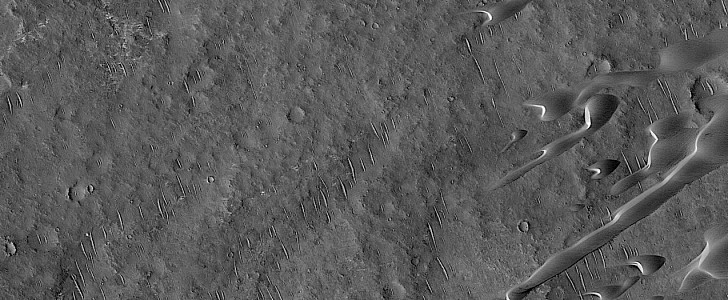If there are two things Mars has plenty of, then that’s dunes and impact craters. By far less spectacular in nature than the holes in the ground left by huge pieces of rocks slamming into the surface at high speeds, dunes do have their role in defining what Mars is all about.
Unlike what we get here on Earth, the dunes of Mars have certain peculiar features to them. First up, it’s their shape, and so far scientists have identified a number of different shapes, from megaripples to barchan.
Then, we have their composition. Most of the sand that makes up the dunes on the Martian surface is of volcanic basalt origin, and that gives it the at times unsettling, darkened appearance.
And, lastly, we have a strange way they choose to evolve, appearing to generally move rather slowly compared to the ones here on Earth, given the weaker winds present there, but sprinting from time to time under the influence of yet unidentified factors that cause dramatic shifts in surface elevation and temperature.
To the naked eye and imaginative human brain, the dunes of Mars may appear as all sorts of wonders, from migrating alien creatures to droplets of a melting Terminator, like we seem to have here.
You’re looking at an image showing the Meroe Patera region of Mars, as seen by the HiRISE camera back in 2020, from an altitude of 270 km (168 miles).
In a manner that becomes more and more unsettling, scientists from NASA and the University of Arizona call these dunes “lovely,” and add that they have “developed in a sand starved region of the dune field, elongating from behind a cliff.”
The reason this photo exists is that the people who run the camera were asked to snap the region “in order to compare morphology to other linear dunes elsewhere on Mars.”
Then, we have their composition. Most of the sand that makes up the dunes on the Martian surface is of volcanic basalt origin, and that gives it the at times unsettling, darkened appearance.
And, lastly, we have a strange way they choose to evolve, appearing to generally move rather slowly compared to the ones here on Earth, given the weaker winds present there, but sprinting from time to time under the influence of yet unidentified factors that cause dramatic shifts in surface elevation and temperature.
To the naked eye and imaginative human brain, the dunes of Mars may appear as all sorts of wonders, from migrating alien creatures to droplets of a melting Terminator, like we seem to have here.
You’re looking at an image showing the Meroe Patera region of Mars, as seen by the HiRISE camera back in 2020, from an altitude of 270 km (168 miles).
In a manner that becomes more and more unsettling, scientists from NASA and the University of Arizona call these dunes “lovely,” and add that they have “developed in a sand starved region of the dune field, elongating from behind a cliff.”
The reason this photo exists is that the people who run the camera were asked to snap the region “in order to compare morphology to other linear dunes elsewhere on Mars.”






